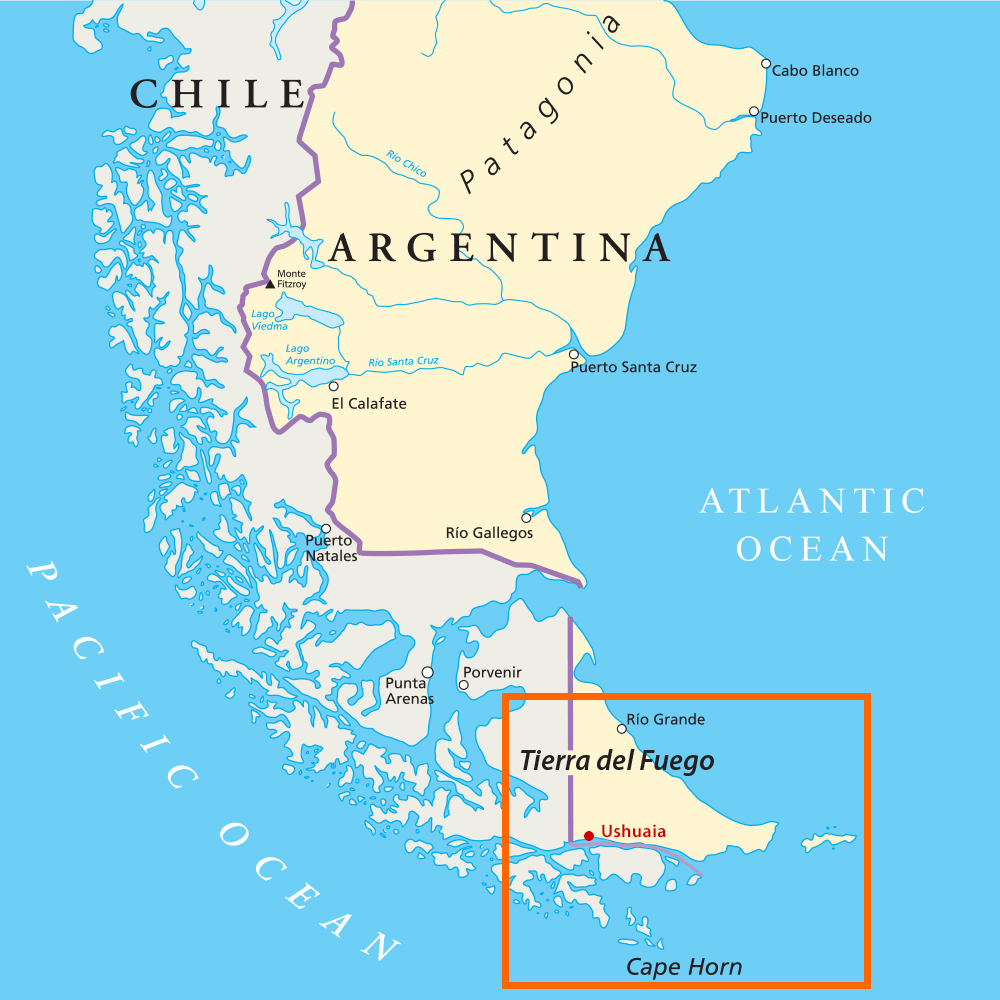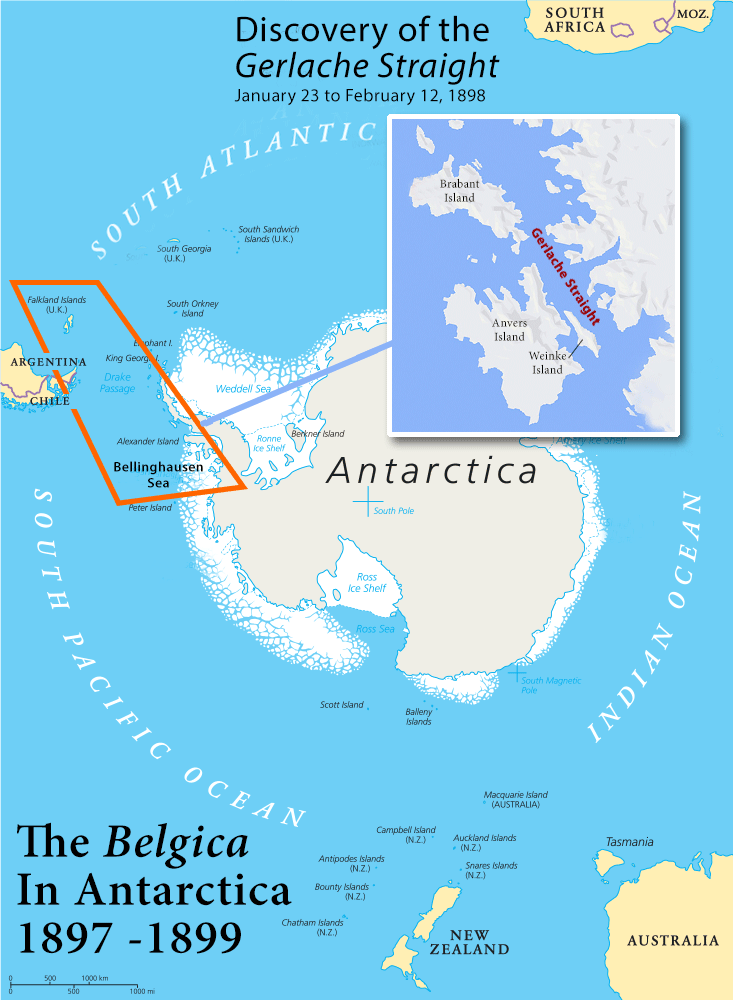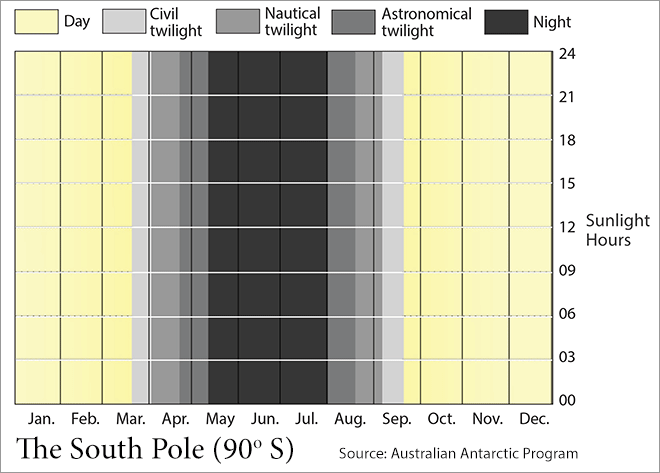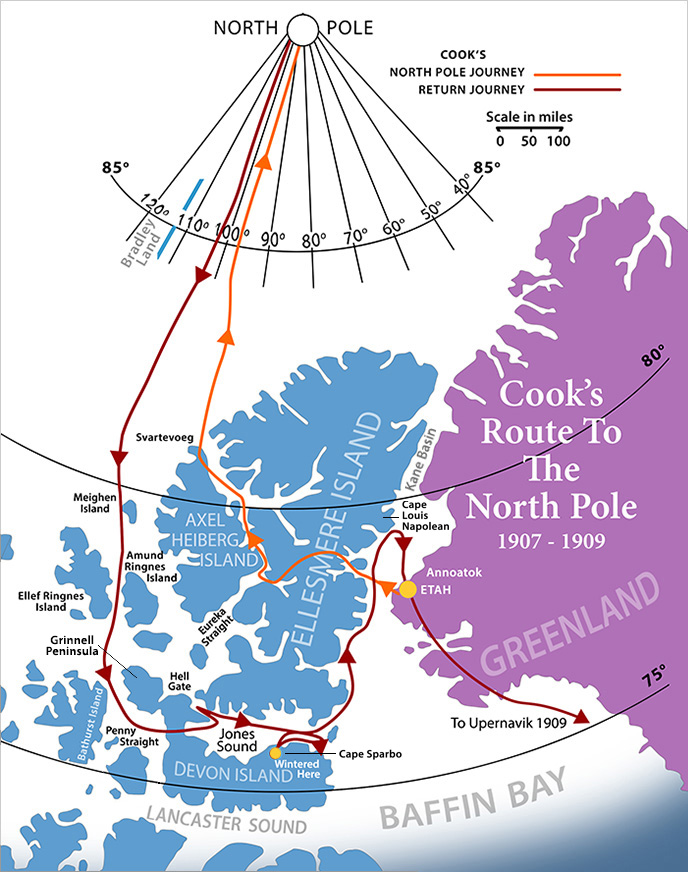Maps of Dr. Frederick Cook’s Explorations
North Greenland (1891 – 1892) | Antarctica (1897 – 1899) | North Pole (1907 – 1909)
Robert E. Peary’s North Greenland Expedition (1891 – 1892)
Dr. Cook’s first polar journey
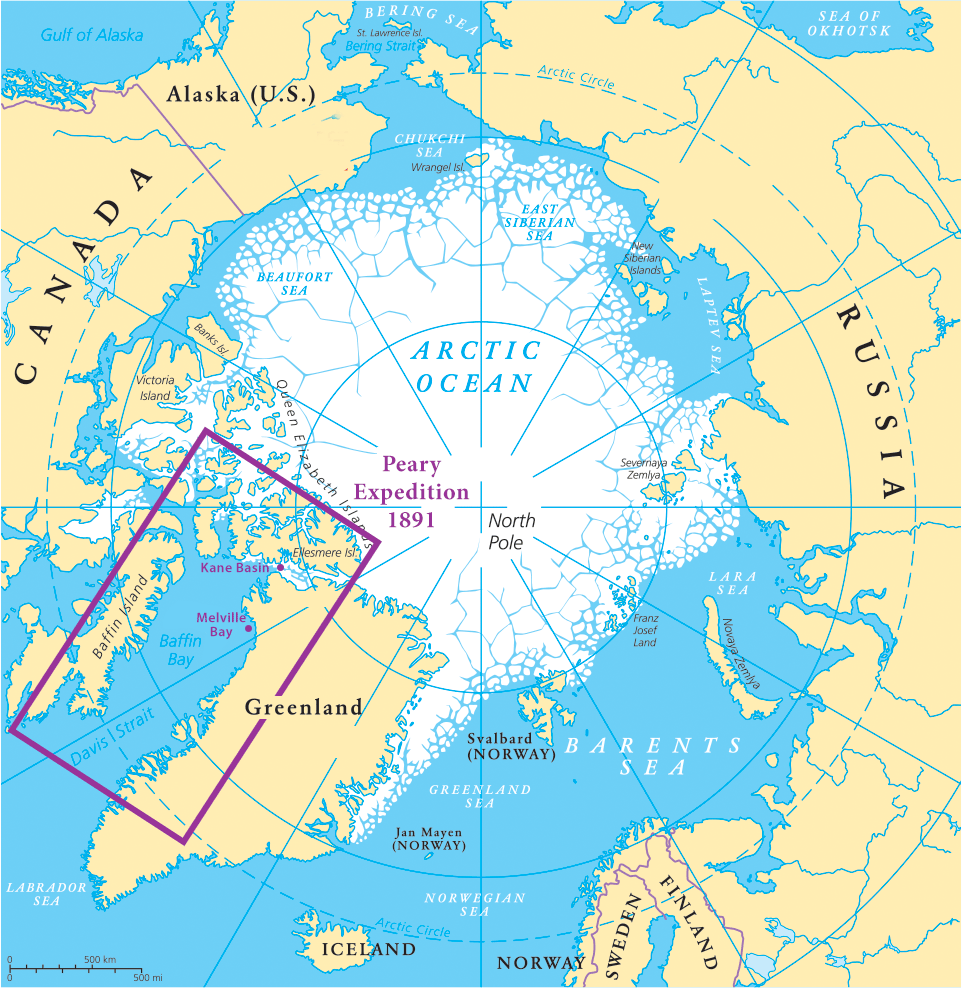
It is unfortunate that the reputations of Peary and Cook became enshrined in the bitter controversy that surrounded their rival claims of being the first to reach the North Pole in 1909. They deserve to be celebrated for their achievements in polar exploration irrespective of that legacy.
For Cook, the time he spent with the Inuit in North Greenland was a life-changing experience. Not only did he learn igloo building, dog handling and other survival basics, he learned the language and embraced the customs of the Greenland Inuit. He had been hired by Peary to serve the expedition as physician and ethnologist. It would be his first polar journey. It is important to note that Ethnology, as a scientific discipline, was in its infancy at the time.
It was on his this expedition that Cook brought a camera. In 1891, cameras were fairly cumbersome pieces of equipment that were not easy to carry around. Thereafter, all of his expeditions were documented with photography. Beside showcasing the eery beauty of remote frozen regions of the world, his precious images provide insight into the extraordinary efforts of his team members as well as rare glimpses into the lives of the indigenous peoples who enabled Cook, Peary and others to survive the harsh environments for which they were woefully unprepared.
The two men had high regard for each other throughout most of the expedition. Cook saved Peary’s leg after it had been fractured horribly in a freakish shipboard accident shortly after their arrival in Melville Bay, Greenland. Peary valued the young physician’s skills and ingenuity in the face of emergencies. For his part, Cook praised Peary’s courage and forbearance in the face of adversity in all the time they spent together.
All members of the expedition, including Peary, were unprepared for the difficulty of life in the frigid conditions of Greenland. According to Dr. Cook’s memoir, “we went through the first Arctic night with the usual half insane mentality of novices. In our stupid stages of unpreparedness, we lived as brothers with the savages. As the twilight of the long night returned, we were equipped for the task at hand…. Peary’s sublime courage saved the day. In returning, all resolved never to venture into the Arctic again.”1 Up until then, Cook’s inspiration had always been the Arctic explorer Elisha Kent Kane who, more than 30 years earlier, reached the bay that was to bear his name. Return to the North Greenland Expedition narrative.
The Belgica Expedition (1897 – 1899)
The ill-fated Belgian expedition to Antarctica
Trouble From The Start
The waters around Cape Horn have claimed more than their fair share of sailors. It has been estimated that at least 800 ships were shipwrecked, causing the deaths of over 10,000 seamen, between the 16th and 20th centuries. “The Horn” marks the point at which the Atlantic and Pacific Oceans meet, making the passage very treacherous. Extreme low-pressure systems whirl across the sea, creating gusts that are sudden, unpredictable and frequent.
Before it was to head south into Antarctic waters, the Belgian expedition under the command of Commandant Adrien de Gerlache de Gomery visited Argentine Tierra del Fuego to resupply its stores of coal and water and offer the ship’s scientists an opportunity to explore. It was also Dr. Cook’s opportunity to study three indigenous tribes; the Alacaluf, Yahgan (who called themselves the Yámana) and the Ona (who called themselves the Selk’nam). As in Greenland, the indigenous people population fascinated him as much as the terrain. (See Cook’s photographs of indigenous people) Charles Darwin, who had visited the area in the early 1830’s aboard the HMS Beagle, had described the natives as “cannibals” who lived in a “miserable state of barbarism”. The Ona were said to be eight-foot-tall warriors.
On the evening of the first day of January 1898, shortly after ten o’clock, it looked like the Belgica was doomed to be shipwrecked in the Beagle Channel in the waters off Ushuaia, a tiny village of twenty structures and a wooden chapel that passed for the Capital of Tierra del Fuego. 2
The author Julian Sancton describes the ordeal best in his book “Madhouse At The End Of The Earth”. Miraculously, the Belgica managed to be freed from the threatening reefs and squalls. However, the accumulation of delays since its departure from Antwerp put the ship and crew far behind schedule in its journey to Antarctic waters.
Order the new book “The Belgica’s Journey Into the Dark Antarctic Night: Madhouse at the End of the Earth” by Julian Sancton. It is the definitive account of the Belgian expedition.
It was on the Belgica Expedition that Cook’s exceptional abilities as an innovative leader, doctor and explorer came to the forefront. He had been recruited to serve on the Beligica based on the sterling reputation he earned on Peary’s North Greenland Expedition four years earlier. Commandant Adrien de Gerlache de Gomery had never met him but was more than willing to allow the illustrious American physician to board the ship in Rio de Janeiro instead of from Antwerp.
It was during this expedition that Cook met Roald Amundsen, the Norwegian explorer who came to be called “The Last of the Vikings”. In 1911 he became the first man to reach the South Pole. On the Belgica, Amundsen was the First Mate. The two men soon formed a friendship that lasted their lifetimes. In this expedition, they went on dangerous scouting missions far from their icebound ship and shared lifesaving survival tips with one another, along with plans for other expeditions. Amundsen had a deep regard for Cook and credited him for being his instructor in the ways of Inuit polar life skills.
The expedition is credited with having discovered the Gerlache Straight in honor of the Belgica’s Commander. In fact, the whole enterprise became entrapped in pack ice and could rightly be called a disaster. It was largely due to Dr. Cook’s gifts as a doctor, psychologist and experienced polar hand that the ship made it back to Belgium.
Return to “About Dr. Frederick Cook.
Cook’s Heroic Measures as a Physician
It was on the Belgica expedition that Cook’s medical talents and polar experience came to the forefront. Shortly before the start of the long Antarctic night he noticed disturbing changes in his companions’ behavior. Melancholy and dread filled the air. Daylight became shorter until the last dim glow of sundown on May 16, 1897. For the next seventy days, sunlight was to be a memory and the perpetual darkness would drive the men to despair and lethargy. Besides the punishing conditions, the thought of being trapped in the ice for the foreseeable future and the recent death of a shipmate, lieutenant Emile Danco, made them wonder “who among us will come after him?”
Amundsen, who dreamed of being a world-famous polar explorer since childhood, approached the dire circumstances as training and rose to the challenge. In the darkness, he explored, exercised, designed and improved equipment and planned other expeditions. Cook, likewise, kept active. His obligations as a physician demanded activity. By nature he was not one to settle into a routine of inactivity. When he wasn’t fulfilling his obligations as the Belgica’s, he was off the icebound ship exploring with Amundsen or out taking photographs of the mysterious surroundings.
Read more about Frederick Cook as a physician
Definitions:
Civil Twilight: the period after sunset or before sunrise ending or beginning when the sun is about 6 degrees below the horizon.
Nautical Twilight: begins in the morning, or ends in the evening, when the geometric center of the sun is 12 degrees below the horizon. In general, the term nautical twilight refers to sailors being able to take reliable readings via well known stars because the horizon is still visible, even under moonless conditions.
Astronomical Twilight: begins in the morning, or ends in the evening, when the geometric center of the sun is 18 degrees below the horizon. … Under astronomical twilight, the horizon is not discernible and moderately faint stars or planets can be observed with the naked eye under a non light polluted sky.
Frederick A. Cook’s North Pole Expedition
(1907 – 1909)
The bitter controversies that surrounded Frederick Cook’s and Robert Peary’s claims of being the first to reach the North Pole greatly damaged the reputations of both men. It appears that neither man achieved that goal. The bitter cold, shifting ice fields, poor visibility, lack of modern navigational equipment and complete isolation without hope for rescue if thing went wrong, were contributing factors to their deception, intentional or unintentional. Volumes have been written about their respective motives for making their audacious claims. One thing their contemporary and present day detractors do agree on, however, is their heroic achievements as explorers in what came to be called the Golden Age of Polar Exploration.
The map below is based on a posthumous 1953 account of Cook’s North Pole expedition published under the direction of his daughter Helene Cook Vetter.3 Based on Dr. Cook’s diaries, notes and recollections, it reaffirms his claims forty five years earlier. Bradley Land, the ephemeral land mass in Latitude 85o that Cook named after his wealthy benefactor, has never been found. It seems to have been a “discovery” as chimerical as Peary’s Croaker Island which, also, has never been found. The stories of polar explorers are filled with accounts of mysterious mirages and shimmering light displays.
Cook’s 1906 trip to Greenland with his benefactor, “Gambler Jim” Bradley, was planned as a hunting expedition. The hunting grounds at Annoatok exceeded the pair’s expectations and the doctor was delighted to reconnect with the Inuit. As he wrote in his journal, Cook “half hoped” that he might make the trip a “jumping off point for the Pole”. Bradley, who was happy to have such a noted explorer with him.was more than willing to encourage and underwrite Cook’s adventure.
When winter approached, Bradley returned to New York on his yacht. His 29 year old ship steward, Rudolf Franke, volunteered to stay with Cook. The two men then spent the next five months in a gloomy hut at Annoatok, ”a land of sorrowful dead”, in Cook’s phrase.
Rewarded with Bradley’s supply of weapons, tools and trade goods, local natives gathered from surrounding villages to outfit the coming venture with clothes made of animal hides, grass insulated boots, light flexible sledges, food and other supplies. Cook was amazed by the ingenuity of the native people and became even more respectful of their ways. He knew that his journey would not be possible without their help and guidance. 4
The Dash to the Pole
On February 19, 1908, 103 dogs were harnessed and hitched to 11 sleds. The average load was 550 pounds, mostly dried meat, fat and skin to serve as food for men and dogs. The plan was to cross the Kane Basin and head for Ellsmere Island. With his indispensable Inuit companions, who readily sought out and killed muskoxen and bear to keep the party from starvation, Cook sledged over the island’s frozen midriff and forged ahead to Axel Heiberg Island. Cold was the fiercest enemy with temperatures dropping below -70o F. In fact, Cook almost died of asphyxia from inhaling the frozen air. He was saved by his native companions who buried him in a snow bank, monitoring his condition from time to time, while building an igloo they could all huddle in for warmth. By March 8th, the party of ten reached the tip of Axel Heiberg Island and camped beneath a monstrous, black-scarred cliff called Svartevoeg.
After a week of resting and regrouping, Franke and seven of the natives were sent back to Ethah. On March 18, 1908, with only Ahwelah and Etukishook (Cook’s spelling) accompanying him and hauling lightest possible equipment, the party began their 600 mi. (approx.) dash to the Pole. The next thirty-five days were grueling as the men and dogs fought their way over and around ice ridges and across open leads in the frozen sea. Cook’s notes and navigational observations were very sketchy at this point. Thereafter, this lack of documentation cast a shadow over all of his claims.
Source: Return From The Pole. Published in 1953 by Cook’s daughter Helene Cook Vetter. W.H. Book Manufacturing Co., USA. Map by Roger Dowd
On April 11th, Cook wrote, he found they had used up half the food supply and the Pole was still two hundred miles away. Nevertheless, exhausted and forging ahead on half rations, ten days later they reached “the spot towards which men have striven for more than three centuries.”
The Pole At Last!
According to Cook, April 21, 1908 was the day he, Ahwelah and Etukishook reached the North Pole. He pinned the Stars and Stripes to a tent pole and, according to his book 3, took a series of observations that established his presence at the very top of the globe. The doctor and his two companions had come six hundred miles in thirty-two days – a rate of nineteen miles a day. He then determined to take a more westerly route back to explore Bradley Land. But Bradley Land was not to be found. They were lost.
From that point on Cook’s notes and observations became more scattered. Weakened and starving, living on half rations, the men and dogs were “in the fearful clutch of a drifting sea of ice”. On May 24th, Cook reckoned his position to be well to the west of Axel Heiberg. Twenty days were to pass before they made their way Hassel Sound, which separates Ellef Ringnes and Amund Ringnes islands.
About the middle of June, Cook wrote, they heard their first animal cry. It was the call of the Snow Bunting. (read Cook’s eloquent journal entry about this incident) Shortly afterwards they landed on a rocky coastline where they hunted bear and small birds. Since departing the Pole they had subsisted on little more than six pounds of food a day and whatever they scrape from the emaciated carcasses of of the dogs that had died or were slaughtered.
From that point on they entered a maze of islands, traveled down Penny Straight between Bathurst Island and the Grinnell Peninsula of Devon Island. The lack of game forced the men to climb the escarpments of North Devon Island and cross into Jones Sound where they released their remaining dogs, jettisoned much of their equipment and embarked on a portable boat that they had taken with them but never used. By early September they reached the soaring granite cliffs off Cape Sparpo.
A Struggle For Survival
It was here that the three men wintered what could only be called Stone Age conditions. Even Cook’s severest critics agreed that the three month trek from Axel Heiberg to Annoatok on Greenland’s coast by way of Cape Sparpo stood as the most remarkable saga in the history of Exploration. The men lived in a small cave hollowed from the earth by tribesman long dead. The discovery of a human skull made them all realize they were making their home in a primitive tomb.
The sun vanished on November 3 and did not return for 110 days. Cook, in the flickering light of a crude oil lamp, set down his account of their polar journey in minute handwriting on prescription pads and tiny memo books. Thus “absolute despair, which in idleness opens the door to madness, was averted”, he wrote. On February 18, with temperatures reaching -40o, the men set off down on Jones Sound toward Baffin Bay. The deep drifting snow and protruding glaciers kept them far from land. When they finally made it to Cape Faraday, they were very grateful for the seal meat Etukishook’s father had cashed away for them. The distraught man also left a crude drawing in soot telling the story of a bereft father looking for his son. The meat had turned rotten, but it was a life saver. They were then on the far side of the sound, only 30 miles from the Greenland coast. But the Sound was open.6
With only the rotten seal meat to sustain them, Cook and his two companions turned north to make a seventy-mile detour on the shore ice towards Cape Louis Napoleon where they could, at last, cross the Kane Basin and scale a tall iceberg. It was the last barrier they had to face before reaching Annoatok. The men – starving, gaunt and filthy – were home at last. After being greeted by a man named Harry Witney, Ahwelah and Etukishook collapsed on their sledges. Cook made a failed attempt to walk further and stumbled to the frozen ground. 7
1 Hell is a Cold Place: ch. 2.1, page 4
2 Sancton, Julian. Madhouse at the End of the Earth: The Belgica’s Journey into the Dark Antarctic Night. Random House. 2021, p. 78
3 Cook, Frederick A., Return from the Pole, Pellegrini & Cudah, New York, 1953
4 Ibid
5 Berton, Pierre, The Arctic Grail, McClellan & Stewart, Toronto, Ontario, 1988
6 Ibid
7 Ibid
* Maps by Roger Dowd
© The Frederick Cook Society | 2022
Sullivan County Museum
265 Main Street, Hurleyville, NY 12747
Mailing Address:
P.O. Box 27. Hurleyville, NY 12747
FACpolar@frederickcookpolar.org
Site design by Roger Dowd Design

